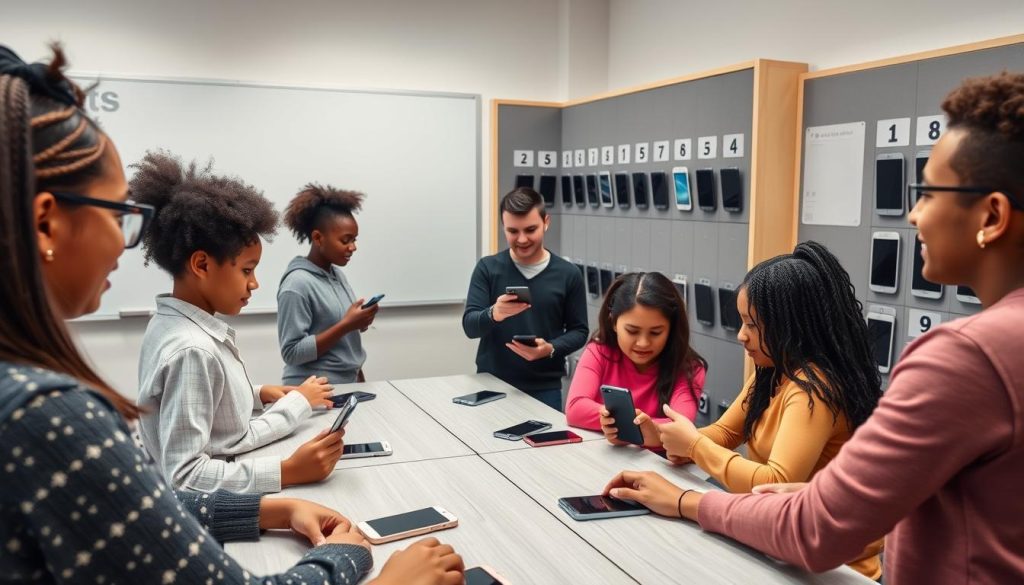Understanding the Challenge of Phones in the Classroom
Recent studies show that 77% of U.S. schools have moved to restrict cellphone use during instructional time. This growing trend reflects mounting evidence that unrestricted phone access significantly impacts student focus, academic performance, and overall classroom dynamics. For teachers, developing effective teacher skills in technology management has become essential to creating productive learning environments.
The constant notifications, social media access, and entertainment options available on smartphones create what researchers call “continuous partial attention” – a state where students are never fully engaged with learning material. This fragmented focus directly impacts comprehension, retention, and classroom participation.
Common Classroom Phone Challenges:
- Constant distractions during instruction
- Unauthorized photos and videos
- Cyberbullying incidents
- Academic dishonesty
- Reduced face-to-face interaction

Before implementing any phone management strategy, it’s important to understand that effective approaches must balance restriction with education. Simply banning devices without teaching responsible use fails to prepare students for a technology-driven world. The most successful teachers develop teacher skills that incorporate digital citizenship education alongside practical management techniques.
Enhance Your Classroom Management Skills
Looking for proven strategies to improve student behavior and create a more focused learning environment? Our Effective Discipline course provides practical techniques specifically designed for today’s classroom challenges.
Developing Effective Policies for Phones in the Classroom
Creating a clear, consistent policy is the foundation of successful phone management. The most effective policies are developed collaboratively, clearly communicated, and consistently enforced. Teacher skills in policy development directly impact how well students adhere to classroom technology guidelines.
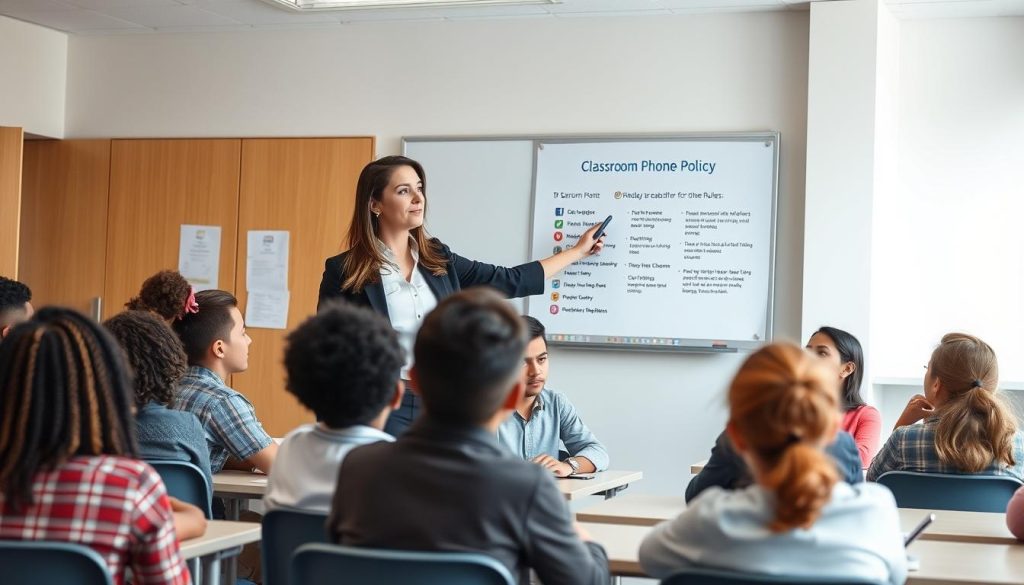
Key Elements of Effective Phone Policies:
Clear Expectations
Define exactly when and how phones may be used. Specify consequences for violations and any exceptions to the rules.
Consistent Enforcement
Apply rules uniformly across all students. Avoid creating a dynamic where some teachers are “strict” while others are “lenient.”
Positive Framing
Focus on the benefits of appropriate technology use rather than just restrictions. Emphasize digital citizenship.
When developing your policy, consider surveying students and parents to understand their perspectives. Many schools find that a collaborative approach increases buy-in and compliance. Teacher skills in stakeholder communication prove invaluable during this process.
“It’s better now that we all have them. A more uniform approach will help us control these devices in the classroom.”
Devon Espejo, Art Teacher, San Marcos High School
Many successful schools have implemented tiered approaches based on grade level. For example, elementary schools might prohibit phones entirely, middle schools might require phones to be stored during the school day, and high schools might allow limited use during specific times.
Whatever policy you develop, ensure it aligns with district guidelines and has administrative support. Document your policy clearly and share it with students, parents, and colleagues to establish consistent expectations.
Discover more classroom management resources at Credits for Teachers
Physical Management Solutions for Phones in the Classroom
Creating physical systems for storing and managing phones can dramatically reduce distractions. These tangible solutions provide clear expectations and remove the temptation of having devices within reach. Developing teacher skills in implementing these systems is crucial for their success.
Popular Phone Storage Solutions:
- Phone Hotels/Pockets: Wall-mounted numbered pockets where students store devices during class
- Charging Stations: Designated areas where phones can be stored and charged
- Lock Boxes: Individual or classroom containers that secure devices
- Phone Parking Lots: Desk organizers with numbered slots for each student

When implementing physical management systems, consistency is key. Establish clear routines for when and how students store and retrieve their devices. Many teachers find that incorporating this process into beginning and end-of-class procedures helps normalize the expectation.
Implementation Tip: Create a visual check-in system where students can see who has properly stored their phone. This peer accountability approach often increases compliance without teacher intervention.
For younger students or in situations where complete restriction is preferred, consider implementing a “zone” system where phones are only allowed in designated areas of the classroom during specific activities. This approach helps develop student self-regulation while maintaining appropriate boundaries.
Remember that physical management systems work best when paired with clear policies and consistent enforcement. The most successful teachers combine organizational teacher skills with effective communication to ensure students understand and follow established protocols.
Instructional Integration of Phones in the Classroom
Rather than viewing phones solely as distractions, skilled educators can transform them into powerful learning tools. Intentional integration of phones into instruction can enhance engagement while teaching responsible technology use. Developing teacher skills in digital integration creates more relevant, dynamic learning experiences.
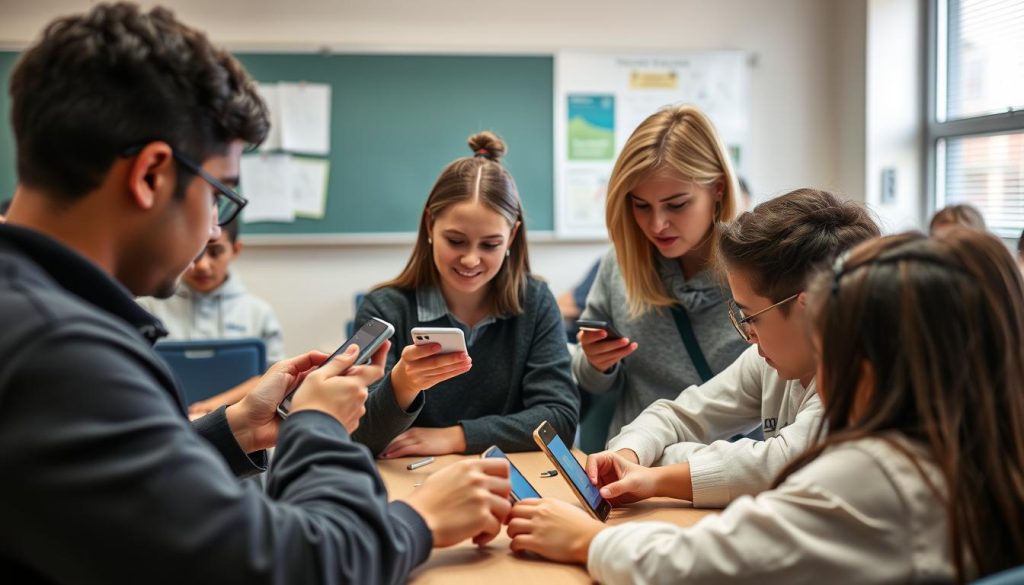
Effective Educational Uses for Phones:
Research Tools
Guide students in using phones for fact-checking, accessing reference materials, and conducting research with proper citation practices.
Interactive Learning
Incorporate educational apps, polling platforms, and digital response systems to increase participation and provide immediate feedback.
Content Creation
Assign projects where students create videos, podcasts, or digital presentations that demonstrate learning in creative formats.
When integrating phones into instruction, clear parameters remain essential. Establish specific guidelines for when devices can be used, which apps or websites are appropriate, and how students should handle distractions. Teacher skills in monitoring and redirecting student attention are particularly important during technology-integrated activities.
“Design better learning activities, design learning activities where you consider how all of your students might want to engage and what their interests are.”
Victor Pereira, Lecturer on Education, Harvard University
Consider implementing a visual signal system to indicate when phone use is appropriate. Many teachers use colored cards, signs, or digital displays to show when phones should be:
- Red: Phones completely away and stored
- Yellow: Phones on desk but face down
- Green: Phones actively used for the current learning activity
This approach helps students develop self-regulation while providing clear expectations. The most effective teachers balance technology integration with traditional learning approaches, using phones strategically rather than constantly.
Expand Your Teaching Toolkit
Looking for more innovative ways to engage students while managing technology? Credits for Teachers offers professional development courses designed to enhance your classroom management and instructional strategies.
Teaching Digital Citizenship Alongside Phone Management
Effective management of phones in the classroom extends beyond rules and restrictions to include education about responsible technology use. Teaching digital citizenship helps students develop the judgment and skills needed for appropriate phone use both in and outside school settings.
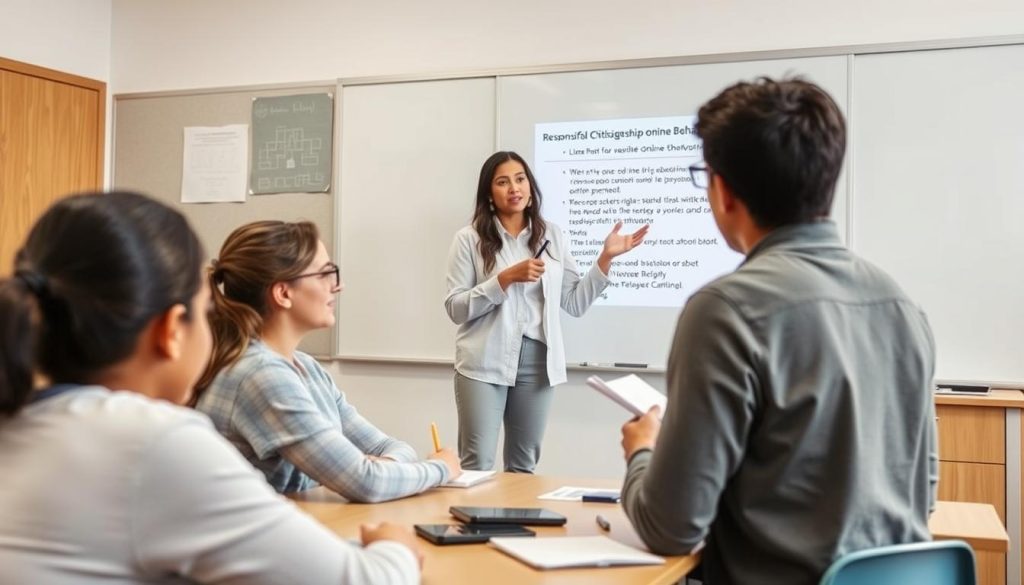
Key Digital Citizenship Concepts:
Digital Footprint
Help students understand that online actions create a permanent record that can impact future opportunities.
Information Literacy
Teach critical evaluation of online sources, fact-checking methods, and recognition of misinformation.
Online Ethics
Discuss appropriate communication, consent for sharing content, and respecting others’ privacy.
Incorporating digital citizenship into your curriculum demonstrates that teacher skills extend beyond subject matter to include preparing students for responsible technology use in all aspects of life. Many educators find that explicit lessons on these topics reduce problematic phone behaviors.
Resource Tip: Common Sense Education offers free digital citizenship curriculum materials for all grade levels, including lesson plans, videos, and family resources.
Consider implementing regular “tech talks” – brief discussions about current technology issues relevant to students. These conversations help normalize responsible technology use while addressing emerging concerns in a proactive manner.
The most effective teachers recognize that digital citizenship education is an ongoing process rather than a one-time lesson. By consistently reinforcing these concepts, you help students develop the judgment needed for appropriate technology use throughout their lives.
Partnering with Parents on Phone Management Strategies
Successful management of phones in the classroom requires strong home-school partnerships. Parents play a crucial role in reinforcing school policies and teaching responsible technology use. Developing teacher skills in parent communication helps create consistent expectations across environments.
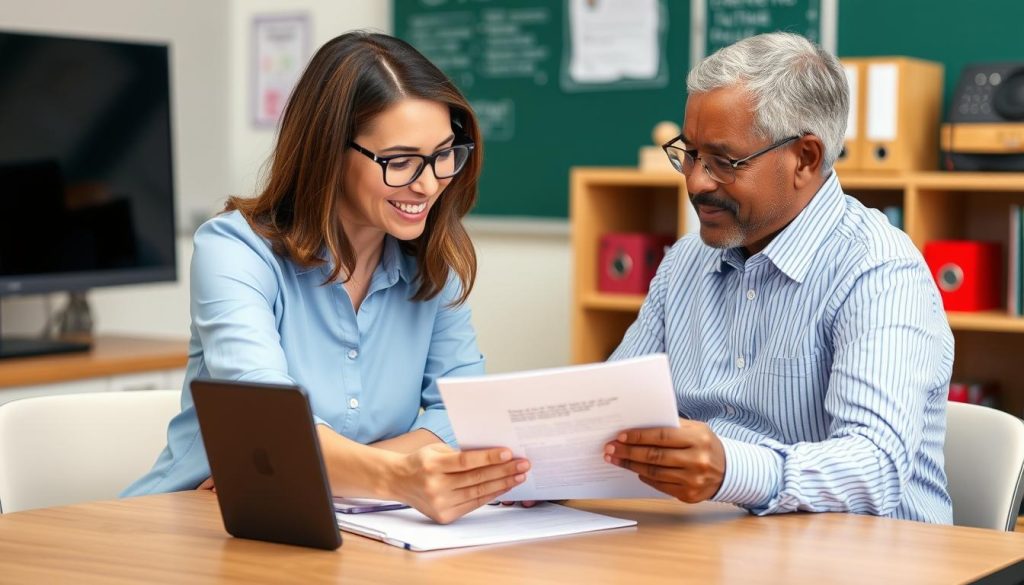
Effective Parent Communication Strategies:
- Share your classroom phone policy at the beginning of the year
- Explain the educational reasoning behind your approach
- Provide specific examples of how phones impact learning
- Offer suggestions for reinforcing responsible use at home
- Create a system for emergency communication that doesn’t disrupt class
“Some parents may be uncomfortable with the policy. But if they were to sit through a class with kids who have access to their phones, and then sit through one where phones were not allowed, they would endorse it.”
Devon Espejo, Art Teacher
Many parents express concern about reaching their children during emergencies. Address this valid concern by establishing clear protocols for emergency communication through school channels. Explain that schools have systems in place to handle emergencies and connect parents with students when truly necessary.
Consider creating a parent resource guide that explains your classroom phone policy, provides tips for healthy technology use at home, and offers conversation starters for discussing digital citizenship with children. This resource demonstrates that teacher skills include supporting families in navigating technology challenges.
Important Note: A recent poll by the National Parents Union found that 78% of parents want their children to have cellphone access during the school day in case of emergency. Addressing this concern directly is essential for policy success.
Regular updates about how phone policies are working in your classroom help maintain parent support. Share both successes and challenges, and be open to feedback that might improve your approach. The most effective teachers view parents as partners in developing students’ responsible technology habits.
Moving Forward: Creating a Balanced Approach to Phones in the Classroom
Managing phones in the classroom requires a multifaceted approach that balances restriction with education. By developing comprehensive policies, implementing physical management systems, integrating phones into instruction when appropriate, teaching digital citizenship, and partnering with parents, you create an environment where technology enhances rather than detracts from learning.
Remember that effective management is an ongoing process that requires consistent attention and adaptation. As technology evolves and new challenges emerge, your teacher skills in this area will continue to develop. The goal isn’t to eliminate technology but to help students learn to use it responsibly and purposefully.
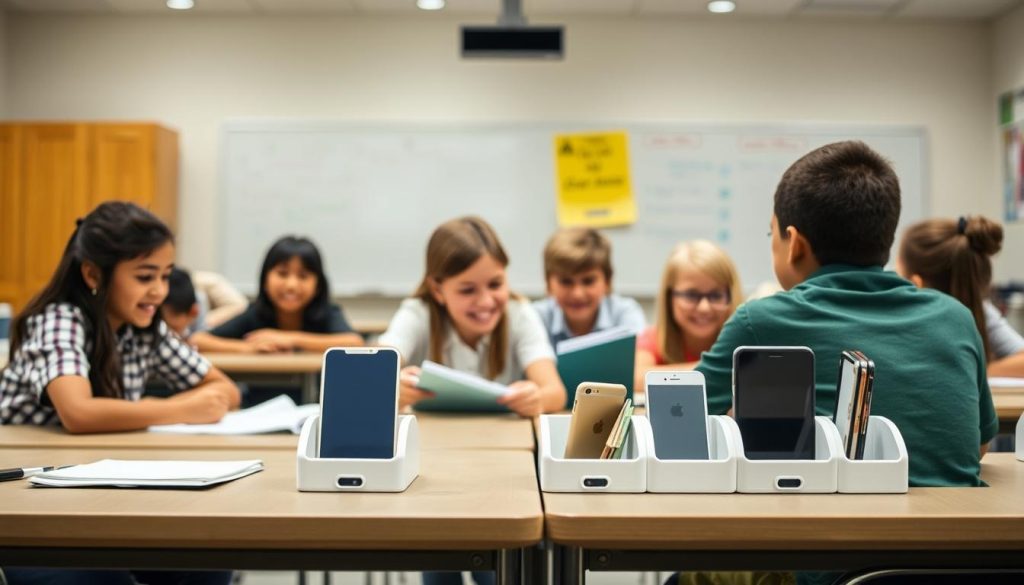
By implementing the strategies outlined in this guide, you can transform the challenge of phones in the classroom into an opportunity to teach valuable life skills while maintaining a focused learning environment. Your efforts in this area prepare students not just for academic success but for responsible technology use throughout their lives.
Continue Your Professional Development
Ready to enhance your classroom management skills and create a more effective learning environment? Credits for Teachers offers specialized courses designed to help you navigate today’s educational challenges.
Frequently Asked Questions About Phones in the Classroom
What if my school doesn’t have a consistent phone policy?
If your school lacks a unified approach, start by establishing clear expectations in your own classroom. Document your policy, communicate it to students and parents, and enforce it consistently. Consider collaborating with colleagues to advocate for a school-wide policy. Many successful school policies began as teacher-led initiatives that demonstrated positive results.
How do I handle parents who insist their child needs phone access?
Listen to parents’ concerns with empathy, as they often stem from safety considerations. Explain your policy’s educational benefits and how it improves the learning environment. Work together to establish alternative communication channels for genuine emergencies, such as messages through the school office. For students with medical needs or other special circumstances, consider developing modified accommodations.
What are the most effective consequences for phone policy violations?
Effective consequences are consistent, proportional, and focused on changing behavior rather than punishment. Many teachers find success with tiered approaches: first violation results in a reminder, second in temporary confiscation, and subsequent violations involve parent contact. Whatever system you implement, apply it uniformly and follow through consistently. Some schools have implemented automated parent notification systems for policy violations.
Developing effective teacher skills in phone management takes time and practice. By implementing these strategies consistently and adapting them to your specific classroom context, you can create an environment where technology enhances rather than detracts from learning.
Ready to Transform Your Classroom Management?
Take the next step in developing your teacher skills with our comprehensive classroom management resources. Our Effective Discipline course provides practical strategies specifically designed for today’s technology challenges.

